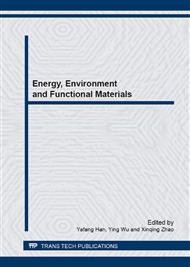p.35
p.41
p.46
p.52
p.58
p.65
p.71
p.76
p.82
Degradation of Sodium Dodecyl Benzene Sulfonate in Surface Water or Clothes Laundering Drain Water with and without Anion via TiO2-Bentonite
Abstract:
Previous studies predominantly degraded organic matter in simulated water samples containing one or two organic components, while a few literatures reported organic matter degradation in natural and actual sewage water samples. This is likely due to the ingredient of surface water or actual sewage coexisted with many kinds of organic pollutants being complex. The relationship among coexisting organic materials is complex during photocatalytic degradation. Moreover, the coexistence of many kinds of inorganic pollutants in natural or actual sewage water samples is also common. Thus, the influence of coexisting inorganic pollutants on degradation is also worthy of study. This work explored these influences of TiO2-bentonite composite catalysts. 8.6%~11.5% sodium dodecyl benzene sulfonate (SDBS) in surface water or clothes laundering drain water was degraded by 3‰ TiO2-bentonite within 6h under 6W ultraviolet light. Under the same conditions, 86.5% of the SDBS in aqueous solution was degraded. The difference was obvious, but the causes were complicated. For example, the influence of , , and on the degradation was discussed. The results show that the influence of on the above degradation was obvious, while and was not obvious. In addition, and were captured by resulting a decrease of degradation speed. Competition of , and SDBS for surface active sites decreased the efficiency of the degradation. Based on these results, pretreatment such as filtering, deposition and impurity removal before actual sewage is degraded could improve the degradation efficiency. Further study, such as on the reasons for efficiency reduction, on new pretreatment methods and on the application of multi-treatment measures, is needed to conduct.
Info:
Periodical:
Pages:
58-64
Citation:
Online since:
April 2014
Authors:
Price:
Сopyright:
© 2014 Trans Tech Publications Ltd. All Rights Reserved
Share:
Citation:


